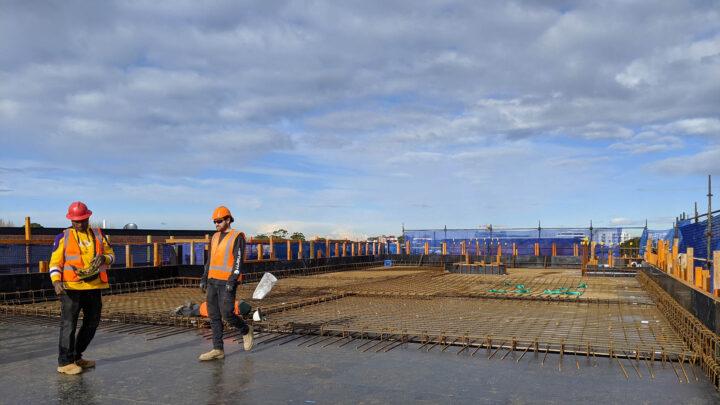
Key Information
InfraBuild has played a key role in the early stages of what will be a landmark Sydney construction.
Foundation work has just finished on a project that will significantly alter Sydney’s skyline once complete. The Crown Sydney project at Barangaroo on the western edge of Sydney’s CBD will stand 75 storeys tall when it is opened early in 2021 and will become the city’s tallest habitable building.
InfraBuild Construction Solutions (formerly LIBERTY OneSteel Reinforcing) has had a large role to play in the project to date through its supply of reinforcing steel for the building’s footings and walls to piling joint venture Piling Contractors Bauer Australia (PCBA JV).

Almost 4000 tonnes of reinforcing bar, mesh and prefabricated material have been delivered to the site at Barangaroo South, which has been touted as one of the most significant waterfront transformations undertaken anywhere in the world.
Urban renewal of the 22-hectare former container port will create a vital new extension for the city of Sydney. The Crown Sydney building itself will become the first six-star hotel to be opened in Sydney and will offer visitors easy access to several of the city’s major attractions.
Challenges faced
The Piling Contractors Bauer Australia joint venture was responsible for the design and construction of the perimeter retaining wall for Crown Sydney’s three-level basement car park, as well as the building’s foundations. Construction work involved the use of diaphragm wall elements (narrow trenches excavated in the ground and supported by an engineering fluid such as bentonite), barrettes (cast-in-place reinforced concrete columns) and bored piles.
Piling required excavating down into the sandstone bedrock and installing steel cages in concrete to provide the structural foundations for the basement and building. The piles were pre-treated with a bentonite-cement-silicate support grout prior to pile excavation in order to improve drilling stability through the fill material.
Before work commenced, however, the group had to contend with remnants of the site’s previous use. As what is now the Barangaroo precinct used to be an old industrial site, treatment needed to be carried out on the contaminated ground. There were also a number of obstructions that needed to be removed, such as concrete, timber piles and even an old sea wall.

Once foundation work at the site commenced, InfraBuild Construction Solutions supplied 2369 tonnes of reinforcing steel to construct the 220m-long perimeter retaining wall extending into the sandstone bedrock. Of that amount, 2285 tonnes was reinforcing bar.
InfraBuild Construction Solutions also supplied just over 1000 tonnes of fabricated material for use in the diaphragm wall. That material facilitated the construction of almost 8000m2 of diaphragm wall up to 1.5m thick.
The PCBA joint venture also installed over 7800m3 of barrettes up to 1.5m thick. The use of barrettes in construction is ideal for projects that are large in size and requiring complementary use of diaphragm walls. Their massive size enables ‘top-down’ construction and they also have a very high vertical load bearing capacity.
However, the bulk and weight of some of the reinforcing cages used in the Crown Sydney barrettes presented significant complications. The largest barrette, a massive T-shaped excavation measuring 6.5m x 5.5m and to a depth of 36.5m, required the installation of a 105-tonne reinforcing cage. The size and complexity of the installation tested the experience not only of the engineers on site, but also the welding operators at InfraBuild Construction Solutions’ Wetherill Park and Revesby sites.

Mark Hogan, Business Improvement Manager at InfraBuild Construction Solutions, says manufacturing and transporting the prefabricated reinforcing cages for the barrettes was a challenge for the company.
“We fabricate our pre-fabricated elements at both Wetherill Park and Revesby and both of those sites have a lifting capacity of 10–12 tonnes on a crane,” Hogan says. “So you can imagine the challenge presented by manufacturing a 100-tonne reinforced cage.
“Added to that complexity was the fact that these cages had a lot of terminators and connection points in them that we had to fit, which is far from being the norm.”
Wall cage assembly
Owing to space restrictions at InfraBuild Construction Solutions’ Revesby site, and the need to abide by strict safety protocols, extreme care also had to be taken in assembling and lifting the diaphragm wall cages. A scaled-down version of the 15m-long cages was produced to test assembly methods and a lifting plan. The full-size cages were then assembled using a method that, for safety, avoided any welding operator having to work within the cage. It was then successfully moved to the loading exclusion zone and on to an extendable trailer for delivery to the site.
As well as the 1003 tonnes of prefabricated materials provided for the diaphragm wall, 428 tonnes were supplied to the site for use in the piling cages. He says that where the cages were unable to be pre-fabricated, loose bar was provided for fabrication on-site.
Lessons learned
Hogan says the project was a fantastic learning experience even for some old heads in the business.
“There were a lot of moving parts involved in servicing this project. Some of those guys who’ve worked in the business 40 years have never seen something so complex,” he said. “We had to build up these hugely complicated elements from scratch, so we had to draw together a team who really knew what they were doing.
“I don’t think we’ll see anything like this again in terms of foundations for a long time,” he said.
Though the Crown Sydney project is unlike any InfraBuild Construction Solutions has taken on before, the challenges have been far outweighed by the satisfaction of working on what is a landmark Sydney project – and a showcase for the infinite possibilities offered by steel.
Images courtesy of High Exposure
Related Case Studies
Subscribe to the
InfraBuild newsletter
Receive regular updates on news, case studies as well as the latest products and services.



